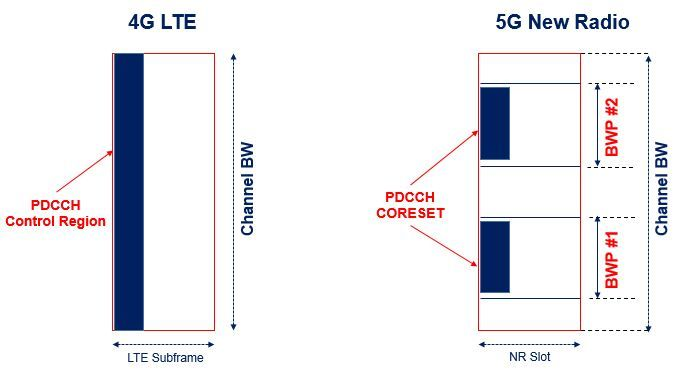Hi Experts.
Does anyone know how exactly CORESET is configured in 5G NR?
Admin note: this post was updated with image below.

Hi Experts.
Does anyone know how exactly CORESET is configured in 5G NR?
Admin note: this post was updated with image below.

Diving very briefly into the basics, we have
1 PRB = 12 sub-carriers.
1 REG = 1 PRB x 1 OFDM symbol (12 sub-carriers in 1 OFDM symbol duration).
For PDCCH,
1 CCE (Control Channel Element) = 6 REGs.
The region of multiple CCEs is referred to as CORESET. The more CCEs you aggregate, while you configure your PDCCH, the more you error protect. [Users located close to the serving gNB can use a lower aggregation level, such as 1, 2 CCEs, while those at the edge of the cell might use 8 or 16 CCEs].
Now, coming to CORESET configuration:
As a part of configuring the device access, the gNB can inform the device of the location of CORESET, as a part of PDCCH configuration, within the initial DL BWP. The positions of the IBWP and SSB typically overlap.
It can help:

In 5G, the PDCCH (Physical Downlink Control Channel) Coreset plays a crucial role in the downlink control channel transmission. The PDCCH Coreset is a set of physical resources that are used for transmitting control information from the base station (gNB) to the user equipment (UE). It carries information related to resource allocation, scheduling, HARQ (Hybrid Automatic Repeat Request), and other control signaling.
Here are some key points about the PDCCH Coreset in 5G:
::-Purpose: The PDCCH Coreset is responsible for carrying downlink control information, such as DCI (Downlink Control Information) messages, which instruct the UEs on how to receive and process the data transmitted on the downlink.
::-Resource Allocation: The PDCCH Coreset is defined in the frequency and time domain and consists of a set of resource elements (REs). The number of REs allocated to the PDCCH Coreset depends on various factors like system bandwidth and configuration.
::-Monitoring: UEs continuously monitor the PDCCH Coreset to detect and decode control information relevant to them. The UE searches for the PDCCH candidates within the PDCCH Coreset by examining specific search spaces.
::-Aggregation Level: The PDCCH Coreset can support different aggregation levels, which determine the number of control channel elements (CCEs) that are aggregated into a single PDCCH candidate. Higher aggregation levels allow for more efficient control channel transmission but reduce the granularity of the control signaling.
::-Control Channel Monitoring Occasions: The PDCCH Coreset can be monitored in different occasions defined by the network, such as common search spaces or dedicated search spaces. These monitoring occasions determine when and how the UEs listen for PDCCH information.
::-Dynamic Allocation: The PDCCH Coreset can be dynamically allocated to UEs based on their scheduling needs and the current network conditions. The network can assign different PDCCH Coresets to different UEs or groups of UEs.
It’s important to note that the details of PDCCH Coresets and their configurations can vary based on the specific 5G deployment scenario, such as frequency bands, duplexing modes (TDD or FDD), and deployment options. The 5G standard provides flexibility for operators to configure PDCCH Coresets based on their network requirements and optimization goals.
Here is a video explaining CORESET configuration in 5G